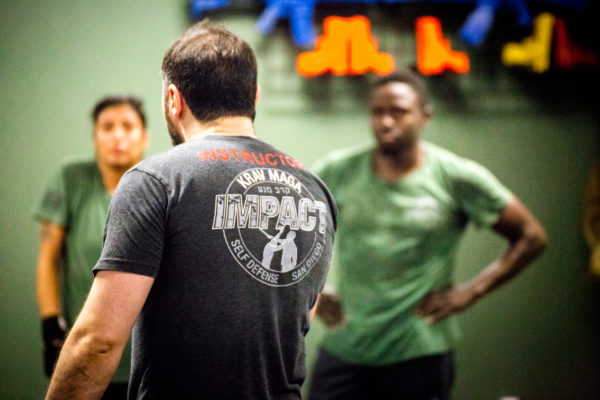

How to Approach Learning Krav Maga
When starting to learn Krav Maga, the task of memorizing the large amount of new techniques may seem daunting. But there are a few strategies you can follow to help guide your training at Impact.
First of all, Krav Maga is a principle driven system that is based on certain natural responses and movements people have shown to exhibit under moments of stress and violence. All techniques are based on these principles, and a lot of patterns of defensive and offensive movements are recycled from one technique to the next, making Krav Maga one of the easiest self-defense systems to learn. Therefore, when we teach techniques, we take the time to explain the “whys” behind each movement to ensure that students don’t fall into the mindset of memorizing the techniques, but rather take the time to understand them. We also ensure that when we teach, we present the same solution to a variety of different scenarios. Like defending a knife stab when standing, how that relates to defending a knife stab when the attacker is mounted on top of you and you are pinned on the ground. So, although it may seem like you are learning two different techniques, in reality you are learning how the principles of a specific technique relate and carry over from one position to the next.
But still, despite our approach to teaching and the natural origins of Krav Maga techniques, new students are required to learn the sequence of movements that compose the technical elements of each choke release, knife stab defense, strikes, and all the other multitude of techniques that Krav Maga has to offer. So how does one tackle learning a new system, and how do you progress and get better with each training session? Here are some stages of learning that we encourage you to consider when training with us.
Stage 1: Start by executing the movements within the technique slowly, and drill them until you don’t have to think about the progression of the movements.
The key is repeating the movements slowly, without striving for speed or fluidity. Many other students working around you may have seen this technique many more times before, and therefore they may be going faster than you in training, since they may be in a different stage of their learning cycle. But as a beginner, slower is better. Speed will come in the later stages of learning, but going too fast too soon, will not allow you to feel the mistakes you are making and make the necessary adjustments to overcome and correct these mistakes, adjust balance, footwork, etc.
Stage 2: Make the sequence of movements within the technique a bit more fluid.
Connecting the movements within the technique is the next stage of learning. For example when learning a choke release, a new student may first do the release, regain balance and then add a counterstrike. A slightly more experienced student will strive to shorten the gap between the release and counterstrike without compromising their balance and footwork. The speed is still moderate, but the sequence of movements is more effortless.
Stage 3: Refine the speed, the strength and the explosiveness of the technique
Once the technique is executed with less effort and more fluidity, the next stage is to become faster and stronger with each movement. If we use a choke as an example, in this stage of learning, the action of releasing the choke should become stronger and more explosive, engaging the body more efficiently, making the counterstrike stronger, and all this while maintaining fluidity, balance and footwork. An outsider looking at a more junior student and the one in the third stage of their learning, should see a clear difference in the way the more experienced student executes the same technique with more force and less effort, showing “ownership” of the technique.
Stage 4: Master the technique
One thing is to know the technique and use it when your instructor asks for it, and the other is to use it correctly when you were least prepared to do so. Although we challenge students to perform each learned technique in the last drill of every class under elevated levels of stress, the real test comes in sparring classes, or advanced classes where students are attacked in a variety of unforeseen ways and the ability to use the technique subconsciously and reflexively is truly tested. Students are expected to rely on their skills to call upon the appropriate technique at the right moment, and all this while exhibiting fluidity of action, explosive power, proper speed, balance and footwork. This truly shows mastery of the technique, and this should be the ultimate goal for every student training Krav Maga at Impact.
Ultimately, it’s not how many techniques you know, but how well you can execute the ones you do when it really counts. So whether you are a beginner to Krav Maga or more experienced student, there is always room for improvement, and this article can be the guideline you need to get better with each training session.
